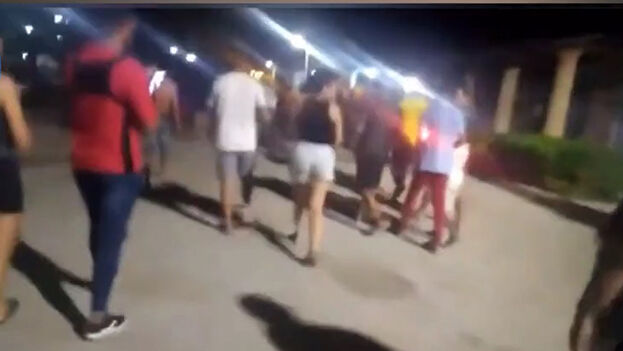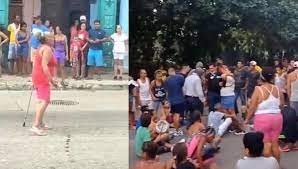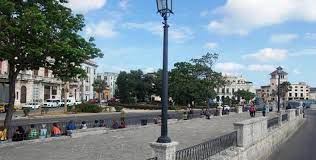
La noche del miércoles hubo manifestaciones en Matanzas, Holguín y Santiago de Cuba, entre otros lugares. (Facebook)
CUBA POR DENTRO: PROTESTAS SE EXTIENDEN A LA CIENAGA DE ZAPATA, MATANZAS, SANTIAGO Y HOLGUIN. PHOTOS.
Se desata la represión ante el aumento de las protestas en Cuba por el quinto día de apagón. Las protestas se extienden a la Ciénaga de Zapata, vitrina de la Revolución cubana. Se oyen también los gritos de “pongan la luz” y “libertad” en Santiago de Cuba, Holguín y Matanzas, entre otros lugares. En Güines tiraron a la Policía piedras y pomos de cristal con excrementos.
LA CIENAGA DE ZAPATA, en Matanzas, considerada una de las vitrinas del régimen cubano, que siempre puso el lugar como ejemplo de sus logros, protagonizó una de las más ruidosas protestas de la noche de este miércoles.
“Pon la luz, pinga, pongan la luz, cojones!”, gritaban en Playa Larga al ritmo de los cacerolazos en medio de las calles, iluminadas tan solo por las linternas de los teléfonos.
En los videos compartidos en redes se ven mujeres con sus niños participando en la manifestación, en la que el grito que más sobresalía era “libertad”. En varios lugares coreaban “el pueblo unido jamás será vencido”, al tiempo que hacían sonar las cazuelas con palos y cucharas.
Los residentes en el barrio Altamira, en Santiago de Cuba, también salieron a protestar. Allí la gente “se tiró para la calle, las personas tocando calderos y protestando en contra del Gobierno para que pusieran la corriente”, relató a este diario un residente del lugar. El hombre explicó que los cacerolazos comenzaron minutos después de que se cortara el servicio de electricidad, y aseguró que al lugar llegaron agentes de la Seguridad del Estado y tropas especiales.
El usuario Echezabal JD compartió en Facebook varios videos de manifestantes en el reparto, una de las zonas más pobres de Santiago de Cuba y más asediadas por la Policía. Allí se encuentra la sede de la Unión Patriótica de Cuba (Unpacu), cuyo líder, José Daniel Ferrer, en la cárcel sin juicio desde el 11 de julio de 2021, anunció el martes una nueva huelga de hambre “hasta las últimas consecuencias”.
Por otro lado, los pobladores de Velasco, en la provincia de Holguín, salieron a manifestarse “enérgicamente en contra del régimen”, aseguró Eduardo Cardet, residente de esa localidad y coordinador del opositor Movimiento Cristiano de Liberación (MCL) a Radio Martí. “La protesta creció recorriendo la avenida principal, congregándose en el parque, y después siguió avanzando por la avenida hasta la Casa de la Cultura. Luego se hizo el recorrido inverso”, señaló.
Para Cardet, la manifestación en Velasco era “para reclamar los cambios que necesitamos” porque, continuó, “es hora ya de que termine este régimen totalitario”.
Usuarios en redes sociales difundieron que también salieron a la calle en Colón (Matanzas).
Proyecto Inventario reportó que en San Andrés, Holguín, sus pobladores salieron a las calles y gritaron “sí se puede” y “libertad”.
La organización, que está recopilando los lugares donde se han producido protestas en respuesta a los largos cortes eléctricos, registró, tan solo el miércoles, siete de ellas.
Hasta 153 manifestaciones, por otra parte, registra Proyecto Inventario a lo largo y ancho de la Isla desde el pasado 14 de julio. Sin embargo, se han vuelto más numerosas, y casi diarias, desde que el huracán Ian azotó el occidente de Cuba y, por razones aún no aclaradas del todo, colapsó el Sistema Eléctrico Nacional.
INSIDE CUBA: PROTESTS SPREAD TO THE CIENAGA DE ZAPATA, MATANZAS, SANTIAGO AND HOLGUIN. PHOTOS.
Repression is unleashed due to the increase in protests in Cuba on the fifth day of the blackout. The protests spread to the Ciénaga de Zapata, showcase of the Cuban Revolution. The cries of “turn on the light” and “freedom” are also heard in Santiago de Cuba, Holguín, and Matanzas, among other places. In Güines they threw stones and glass jars with excrement at the Police.
LA CIENEGA DE ZAPATA, in Matanzas, considered one of the showcases of the Cuban regime, which always held the place as an example of its achievements, staged one of the loudest protests on Wednesday night.
“Put on the light, dick, put on the light, damn it!”, they shouted in Playa Larga to the rhythm of pot-banging in the middle of the streets, illuminated only by the flashlights of the telephones.
In the videos shared on networks, women with their children are seen participating in the demonstration, in which the cry that stood out the most was “freedom.” In several places, they chanted “the people united will never be defeated”, while they banged pots with sticks and spoons.
Residents in the Altamira neighborhood, in Santiago de Cuba, also came out to protest. There, people “threw themselves into the street, people touching cauldrons and protesting against the government so that they would turn on the current,” a local resident told this newspaper. The man explained that the cacerolazos began minutes after the electricity service was cut off, and assured that State Security agents and special troops arrived at the scene.
The user Echezabal JD shared on Facebook several videos of protesters in the district, one of the poorest areas of Santiago de Cuba and the most besieged by the Police. There is the headquarters of the Patriotic Union of Cuba (Unpacu), whose leader, José Daniel Ferrer, in jail without trial since July 11, 2021, announced on Tuesday a new hunger strike “until the last consequences.”
On the other hand, the residents of Velasco, in the province of Holguín, came out to demonstrate “energetically against the regime,” Eduardo Cardet, a resident of that town and coordinator of the opposition Christian Liberation Movement (MCL), told Radio Martí. “The protest grew along the main avenue, congregating in the park, and then continued along the avenue to the House of Culture. Then the reverse route was made,” he said.
For Cardet, the demonstration in Velasco was “to demand the changes we need” because, he continued, “it is time for this totalitarian regime to end.”
Users on social networks reported that they also took to the streets in Colón (Matanzas).
Project Inventory reported that in San Andrés, Holguín, its residents took to the streets and shouted “yes we can” and “freedom.”
The organization, which is collecting the places where protests have taken place in response to the long power outages, recorded seven of them on Wednesday alone.
Up to 153 demonstrations, on the other hand, registered Project Inventory throughout the Island since last July 14. However, they have become more numerous, and almost daily, since Hurricane Ian hit western Cuba and, for reasons not yet fully clarified, collapsed the National Electric System.
Agencies/ 14yMedio, La Habana/ Extractos/ Excerpts/ Internet Photos/ Arnoldo Varona/ www.TheCubanHistory.com
THE CUBAN HISTORY, HOLLYWOOD.



 CUBA POR DENTRO: Protestas se extienden a la Cienaga de Zapata, Santiago, Holguín y Matanzas. PHOTOS. * INSIDE CUBA: Protests Spread to the Cienaga de Zapata, Matanzas, Santiago and Holguin. PHOTOS.
CUBA POR DENTRO: Protestas se extienden a la Cienaga de Zapata, Santiago, Holguín y Matanzas. PHOTOS. * INSIDE CUBA: Protests Spread to the Cienaga de Zapata, Matanzas, Santiago and Holguin. PHOTOS.





